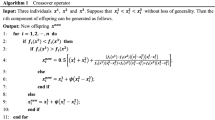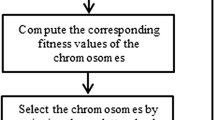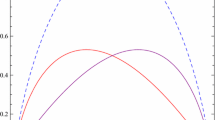Abstract
This paper proposes the fuzzy mean-entropy portfolio models with transaction costs based on credibility theory. In the paper, entropy is used as the measurement of risk. Furthermore, sensitivity analysis is discussed for objective function coefficients and constraint coefficients on the right sides in our proposed models. In addition, two numerical examples are given to illustrate the effectiveness of our proposed models and the practicability of sensitivity analysis. More importantly, the obtained results also show that when certain coefficient changes in some value range, we still can obtain the unchanged optimal solutions or unchanged objective function values. Compared with Huang (IEEE Trans Fuzzy Syst 16:1096–1101, 18; Fuzzy Optim Decis Mak 10:71–89, 19), our paper not only proposes the mean-entropy models, but also does research work on sensitivity analysis about objective function coefficients and constraint coefficients in depth in maximizing return model and minimizing risk model. Our results can provide more choices for investors in the practical financial market.



Similar content being viewed by others
References
Markowitz, H.: Portfolio selection. J. Financ. 7, 77–91 (1952)
Markowitz, H.: Portfolio Selection: Efficient Diversification of Investment. Wiley, New York (1959)
Markowitz, H.: Mean-Variance Analysis in Portfolio Choice and Capital Markets. Basil Blackwell, Oxford (1987)
Best, M.J., Hlouskova, J.: The efficient frontier for bounded assets. Math. Methods Oper. Res. 52, 195–212 (2000)
Merton, R.C.: An analytic derivation of the efficient frontier. J. Financ. Quantit. Anal. 9, 1851–1872 (1972)
Pang, J.S.: A new efficient algorithm for a class of portfolio selection problems. Oper. Res. Int. J. 28, 754–767 (1980)
Perold, A.F.: Large-scale portfolio optimization. Manag. Sci. 30, 1143–1160 (1984)
Sharpe, W.F.: Portfolio Theory and Capital Markets. McGraw-Hill, New York (1970)
Stein, M., Branke, J., Schmeck, H.: Efficient implementation of an active set algorithm for large-scale portfolio selection. Comput. Oper. Res. 35, 3945–3961 (2008)
Anagnostopoulos, K.P., Mamanis, G.: The mean-variance cardinality constrained portfolio optimization problem: an experimental evaluation of five multiobjective evolutionary algorithms. Expert Syst. Appl. 38, 14208–14217 (2011)
Liu, B.D.: Uncertainty Theory, 3rd edn. Spring-Verlag, Berlin (2010)
Liu, B.D.: A survey of credibility theory. Fuzzy Optim. Decis. Mak. 5, 387–408 (2006)
Liu, B.D., Iwamura, K.: Chance constrained programming with fuzzy parameters. Fuzzy Sets Syst. 94, 227–237 (1998)
Amiri, M., Ekhtiari, M., Yazdani, M.: Nadir compromise programming: a model for optimization of multi-objective portfolio problem. Experts Syst. Appl. 38, 7222–7226 (2011)
Bhattacharyya, R., Kar, S., Majumder, D.D.: Fuzzy mean-variance-skewness portfolio selection models by interval analysis. Comput. Math. Appl. 61, 126–137 (2011)
Dastkhan, H., Gharneh, N.S., Golmakani, H.R.: A linguistic-based portfolio selection model using weighted max-min operator and hybrid genetic algorithm. Expert Syst. Appl. 38, 11735–11743 (2011)
Philippatos, G.C., Wilson, C.J.: Entropy, market risk, and the selection of efficient portfolios. Appl. Econ. 4, 209–220 (1972)
Huang, X.X.: Mean-Entropy models for fuzzy portfolio selection. IEEE Trans. Fuzzy Syst. 16, 1096–1101 (2008)
Huang, X.X.: Mean-risk model for uncertain portfolio selection. Fuzzy Optim Decis Mak 10, 71–89 (2011)
Mukesh, K.M.: Credibilistic mean-entropy models for multi-period portfolio selection with multi-choice aspiration levels. Inf. Sci. 345, 9–26 (2016)
Zhou, R.X., Zhan, Y., Cai, R., Tong, G.Q.: A mean-variance hybrid-entropy model for portfolio selection with fuzzy returns. Entropy 17, 3319–3331 (2015)
Zhang, W.G., Zhang, X.L., Chen, Y.X.: Portfolio adjusting optimization with added assets and transaction costs based on credibility measures. Insur. Math. Econ 49, 353–360 (2011)
Sadjadi, S.J., Seyedhosseini, S.M., Hassanlou, K.H.: Fuzzy multi period portfolio selection with different rates for borrowing and lending. Appl. Soft Comput. 11, 3821–3826 (2011)
Li, P., Liu, B.D.: Entropy of credibility distributions for fuzzy variables. IEEE Trans. Fuzzy Syst. 16, 123–129 (2007)
Liu, S.T.: The mean-absolute deviation portfolio selection problem with interval-valued returns. J. Comput. Appl. Math. 235, 4149–4157 (2011)
Liu, S.T.: A fuzzy modeling for fuzzy portfolio optimization. Experts Syst. Appl. 38, 13803–13809 (2011)
Qin, Z.F., Li, X., Li, X.Y.: Portfolio selection based on fuzzy cross-entropy. J. Comput. Appl. Math. 228, 139–149 (2009)
Zhou, R.Z., Yang, Z.B., Yu, M.: A portfolio optimization model based on information entropy and fuzzy time series. Fuzzy Optim Decis. Mak. 14, 381–397 (2015)
Yue, W., Wang, Y.P.: A new fuzzy multi-objective higher order moment portfolio selection model for diversified portfolios. Phys. A 465, 124–140 (2017)
Chen, W., Wang, Y., Mehlawat, M.K.: A hybrid FA-SA algorithm for fuzzy portfolios selection with transaction costs. Ann. Oper. Res. (1047). doi:10.1007/s9-016-2365-3
Zadeh, L.A.: Fuzzy sets. Inf. Control 8, 338–353 (1965)
Zadeh, L.A.: Fuzzy sets as a basis for a theory of possibility. Fuzzy Sets Syst. 1, 3–28 (1978)
Acknowledgements
This research was supported by “the National Natural Science Foundation of China, No. 11271140,” “the Ministry of Education, Humanities and Social Sciences Youth Fund Project of China, No. 13YJCZH030,” “the Natural Science Foundation of Guangdong Province, No. 2016A030313545” and “the Graduate Education Innovation Projects of Guangdong Province, Nos. 2015JGXM-ZD03, 2016QTLXXM-19.” The authors are highly grateful to the referees and editor-in-chief for their very helpful comments and suggestions.
Author information
Authors and Affiliations
Corresponding author
Rights and permissions
About this article
Cite this article
Deng, X., Zhao, J. & Li, Z. Sensitivity Analysis of the Fuzzy Mean-Entropy Portfolio Model with Transaction Costs Based on Credibility Theory. Int. J. Fuzzy Syst. 20, 209–218 (2018). https://doi.org/10.1007/s40815-017-0330-1
Received:
Revised:
Accepted:
Published:
Issue Date:
DOI: https://doi.org/10.1007/s40815-017-0330-1




